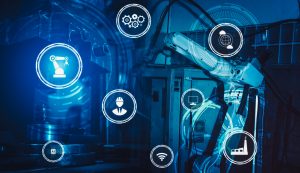Digital technologies have been integrated into almost every aspect of business in the last few years, and manufacturing is no exception. We are seeing a rise in smart manufacturing and smart factories driven by the changes in how businesses deliver value to customers. But what is specifically happening in the industry? What do manufacturers need to be aware of in order to stay ahead of the competition?
First, the Fourth Industrial Revolution, or Industry 4.0, isn’t new. The term was coined some five years ago to encapsulate a whole wave of technologies changing the industry, from AI to 3D printing, and other “smart factory” elements. Still, while manufacturing as a whole seemed to be quick to jump into digital transformation initially, in our 2020 Digital Transformation Index we found that the commitment has waned, and it is now one of the lagging industries. Why? For some companies, it’s due to a wide range of legacy systems that still exist on the production floor, making it hard to focus on larger, enterprise-wide efforts. For others, it’s simply a legacy-centric culture that prevents a drive to move forward.
On the plus side, there are several areas of opportunity and digital transformation strategies that could continue to drive the industry forward.
Transforming Manufacturing with Data
The global economy no longer runs on dollars — it runs on data. And while data is often thought of as something to give insights into customer behaviors or to help provide more personalized marketing plans, it’s also essential to helping manufacturing floors and businesses run stronger. One of the earliest ways manufacturers used data was for predictive maintenance — being able to proactively determine when machines should be shut down for repair or regular maintenance. This, in turn, led to more efficient lines. 
Still, there are many different ways data can be used beyond predictive maintenance. For instance, collecting data can improve insights on product quality — allowing companies to track how long a product lasts, which element of a product breaks down, or the overall value of the product in terms of how long it remains functional. Data can also help manufacturers better understand things like throughput and productivity — whether products are being created in the optimal setting to maximize output.
One caveat: In order to unlock the immense value from data, manufacturers need to not just collect but connect and coordinate their machines via the IoT. If not, they face a flood of uncoordinated data from an untold number of devices on various platforms. Operations and plant teams must work tightly together to collect data from many sources, cleanse data, create consistent names for data points, agree to use it to make decisions regarding plant processes, and enrich it with data from other streams. Only then will the full value of data be seen.
Doubling Down on Digital Twins
What can you build with the right data? A digital twin. When it comes to manufacturing, digital twins may be the single most important technology to hit the scene. Using data to create a digital version of a real process or machine, digital twins can help optimize productivity, profitability, and more without the need to invest in a physical product. Using digital twins, companies can improve processes, control quality, test for safety, improve supply chain management (modeling fleet and route efficiency and package performance), and determine just-right production for just-in-time manufacturing. Digital twins can also be used to improve things like customer and employee experience by allowing those groups to test new processes and products before they ever make it to the real world.
Focusing on Collaboration and the Power of the Ecosystem
Manufacturing can no longer be done in a traditional “line” format. A continued growth of technology and globalization has made it impossible  to succeed without moving in multiple directions. Collaborating and expanding an organization’s manufacturing ecosystem is a critical step for our global economy. This would allow manufacturers to create new business models, find new value in existing models, and outsource processes that are a drain on resources. Working with other manufacturers to find solutions, build products, and meet customer expectations is a necessary strategy for the future.
to succeed without moving in multiple directions. Collaborating and expanding an organization’s manufacturing ecosystem is a critical step for our global economy. This would allow manufacturers to create new business models, find new value in existing models, and outsource processes that are a drain on resources. Working with other manufacturers to find solutions, build products, and meet customer expectations is a necessary strategy for the future.
There is no shortness of technology when it comes to transforming the manufacturing space. By focusing strategically on investments in connected data, digital twins, and collaboration, organizations can successfully move through the Fourth Industrial Revolution and beyond.
###
Watch our recent 3DEXPERIENCE Dialogue, “Digital Transformation: Where Do We Go From Here?” featuring a panel discussion moderated by Shelly Kramer, Futurum Research including the following participants:
- Isaac Sacolick, Influencer, Author of Driving Digital
- Travis Hessman, Group Editorial Director, Endeavor Media Group and Editor-in-Chief, IndustryWeek
- Shawn Ehrstein, Director, Emerging Technologies & CAD/CAM, National Institute for Aviation Research, Wichita State University
- Garrett Thurston, Industry Solution Experience Director, Dassault Systèmes
